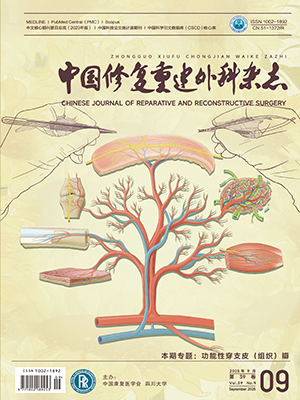| 1. |
丁舒晨,马超然,王哲洋,等.前列腺素E2在肩袖损伤中作用的研究.中国骨与关节杂志, 2013, 2(12):712-715.
|
| 2. |
Galatz LM, Charlton N, Das R, et al. Complete removal of load is detrimental to rotator cuff healing. J Shoulder Elbow Surg, 2009, 18(5):669-675.
|
| 3. |
DING SC, MA CR, QIU YS, et al. Suture-bridge technique can improve structual healing rate for arthroscopic rotator cuff repair comparing with double-row technique:a meta-analysis.中国矫形外科杂志, 2014, 22(14):1249-1255.
|
| 4. |
丁舒晨,田臻,马超然,等.微创建立大鼠慢性肩袖损伤模型.中国修复重建外科杂志, 2014, 28(10):1225-1230.
|
| 5. |
Ficklscherer A, Hartl TK, Scharf M, et al. Effects of selective paralysis of the supraspinatus muscle using botulinum neurotoxin a in rotator cuff healing in rats. J Orthop Res, 2013, 31(5):716-723.
|
| 6. |
Fukui D, Kawakami M, Yoshida M, et al. Gait abnormality due to spinal instability after lumbar facetectomy in the rat. Eur Spine J, 2015, 24(9):2085-2094.
|
| 7. |
Forgione N, Karadimas SK, Foltz WD, et al. Bilateral contusion-compression model of incomplete traumatic cervical spinal cord injury. J Neurotrauma, 2014, 31(21):1776-1788.
|
| 8. |
李奉龙,姜春岩,鲁谊,等.兔肩袖损伤模型的建立及初步组织学研究.中国组织工程研究, 2012, 16(20):3685-3689.
|
| 9. |
Zhang S, Li H, Tao H, et al. Delayed early passive motion is harmless to shoulder rotator cuff healing in a rabbit model. Am J Sports Med, 2013, 41(8):1885-1892.
|
| 10. |
Park GY, Kwon DR, Lee SC. Regeneration of full-thickness rotator cuff tendon tear after ultrasound-guided injection with umbilical cord blood-derived mesenchymal stem cells in a rabbit model. Stem Cells Transl Med, 2015, 4(11):1344-1351.
|
| 11. |
Chen X, Giambini H, Ben-Abraham E, et al. Effect of bone mineral density on rotator cuff tear:an osteoporotic rabbit model. PLoS One, 2015, 10(10):e0139384.
|
| 12. |
Fabis J, Danilewicz M, Zwierzchowski JT, et al. Atrophy of type I and II muscle fibers is reversible in the case of grade >2 fatty degeneration of the supraspinatus muscle:an experimental study in rabbits. J Shoulder Elbow Surg, 2015.[Epub ahead of print].
|
| 13. |
Kim SH, Kim J, Choi YE, et al. Healing disturbance with suture bridge configuration repair in rabbit rotator cuff tear. J Shoulder Elbow Surg, 2015.[Epub ahead of print].
|
| 14. |
Björnsson HC, Norlin R, Johansson K, et al. The influence of age, delay of repair, and tendon involvement in acute rotator cuff tears:structural and clinical outcomes after repair of 42 shoulders. Acta Orthop, 2011, 82(2):187-192.
|
| 15. |
Aoki S, Sato Y, Yanagihara D. Characteristics of leading forelimb movements for obstacle avoidance during locomotion in rats. Neurosci Res, 2012, 74(2):129-137.
|
| 16. |
Sato Y, Aoki S, Yanagihara D. Gait modification during approach phase when stepping over an obstacle in rats. Neurosci Res, 2012, 72(3):263-269.
|
| 17. |
Schneeberger AG, Nyffeler RW, Gerber C. Structural changes of the rotator cuff caused by experimental subacromial impingement in the rat. J Shoulder Elbow Surg, 1998, 7(4):375-380.
|
| 18. |
Carpenter JE, Thomopoulos S, Flanagan CL, et al. Rotator cuff defect healing:a biomechanical and histologic analysis in an animal model. J Shoulder Elbow Surg, 1998, 7(6):599-605.
|
| 19. |
Morbiato L, Carli L, Johnson EA, et al. Neuromuscular paralysis and recovery in mice injected with botulinum neurotoxins A and C. Eur J Neurosci, 2007, 25(9):2697-2704.
|
| 20. |
Nagata C, Ido M, Shimizu H, et al. Choice of response scale for health measurement:comparison of 4, 5 and 7 point seales and visual analog scale. Journal of Epidemiology, 1996, 6(4):192-197.
|




